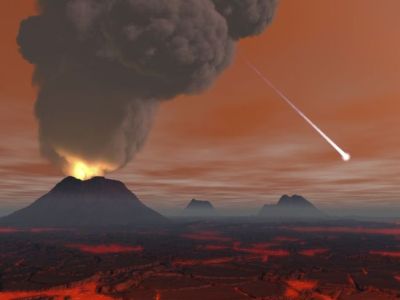
| PalŠos: |  |
The Hadean Eon |
| TIME | The Hadean Eon |
| Page Back | Unit Home (You are here) |
Included in: Precambrian | Main topic: Timescale | Page Next: Hadean |
| Timescale Back: Chaotian (earlier) |
Planetary timescales (parallel) |
Includes: Hadean overview (more detail) |
Earth (formed during Hadean) |
Timescale Next: Archean (later) |
| Timescale Chaotian Palaeohadean Mesohadean Neohadean Archean Proterozoic Phanerozoic |
The Hadean Eon Overview of the Hadean Hadean Timescale Notes and References |
 Surface of the Earth during the Hadean eon, presumably the Hephaestean period) - Copyright 1994-2011, Streamlined Technology, LLC and Barewalls Interactive Arts, Stocktrek Images original url see also artwork by Hermann Trappman |
The Chaotian Eon ended with a collision between the young proto-Earth and an almost Mars-sized body (which has been named Theia after the mother of the Moon goddess Selene) (Halliday, 2000) . This ejecta from this gigantic collision eventually formed into the moon, whilst denser matter from both protoplanets ended up as the Earth. The originally molten Earth soon cooled, although the Earth's surface was continually bombarded by meteorites, and the much hotter mantle would have resulted in severe volcanism. At this time, the Earth would have perhaps looked rather like the above drawing, an alien and inhospitable world, which is the Hadean in the popular imagination. However there very soon formed oceans or seas (either through comets or volcanic outgassing), and an atmosphere, and for most of the Hadean, conditions were milder. It is possible that some form of microbial life may have also appeared. If it did it is not certain whether it would have survived the period of intense meteorite impacts known as the "Late Heavy Bombardment" (Gomes et al 2005), , although the tenacity of extromophile microbes might argue in favour. The end of this period, around 3.8 billion years ago, marked the end of the Hadean and the beginning of the Archean eon.
| Page Back | Unit Home (You are here) |
Page Top | Page Next: Hadean |
